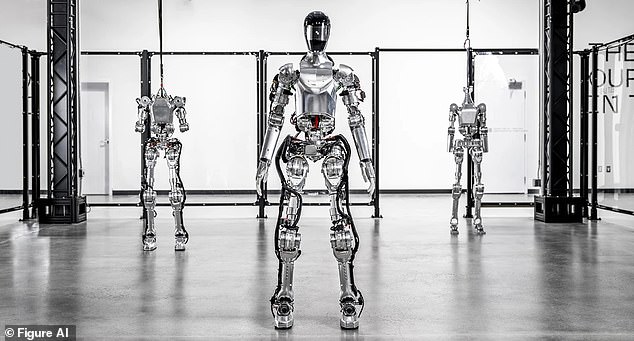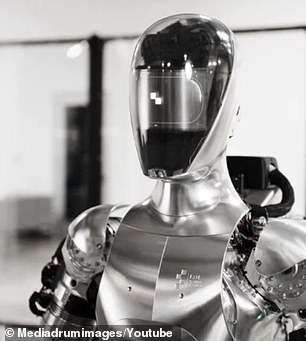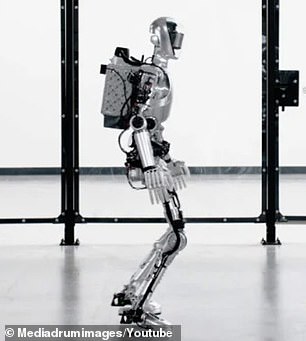The biggest names in technology, from Amazon to Microsoft, have invested approximately $675 million in a robotics startup whose “master plan” is to bring the first commercial, AI-powered “humanoid” to market.
The funding round is almost ten times larger than the $70 million that this new robotics company, Figure AI, managed to raise last May.
Amazon founder Jeff Bezos, through his venture firm Explore Investments LLC, pledged an optimistic figure of $100 million to the company, and Microsoft invested almost the same amount, $95 million.
Figure AI hopes its first AI humanoid robot, Figure 01, will prove capable of performing jobs too dangerous for human workers and could alleviate the worker shortage.
For now, the humanoid machine has proven itself adept at making a cup of coffee.

Figure AI hopes its first AI humanoid robot, Figure 01, will prove capable of performing jobs too dangerous for human workers and could alleviate the worker shortage. Amazon’s Jeff Bezos has pledged $100 million, and Microsoft invested almost the same amount, $95 million, in Figure
‘“We hope to be one of the first groups to bring a humanoid to market,” Figure AI CEO Brett Adcock told reporters last May, “that can actually be useful and do business.”
Just over six months after that $70 million funding round last May, Figure AI announced a first-of-its-kind deal to put Figure 01 to work in BMW factories.
The German automaker has struck a deal to use Figure 01 humanoids for the first time at a BMW plant in Spartanburg, South Carolina, a sprawling, multimillion-dollar facility that includes high-voltage battery assembly and electric vehicle manufacturing.
While the announcement was short on details about the precise job tasks of robots at BMW, the companies described their intention to “explore advanced technology topics” as part of their “milestone-based approach” collaboration approach.
On the agenda for Figure AI and BMW, the two companies said, were “artificial intelligence, robot control, manufacturing virtualization and robot integration”—business speak for sci-fi levels of advanced automation.
Adcock said axios that, in his opinion, Figure AI robots “can do basically everything a human can do.”
If these boasts prove true, Figure has attracted the attention of hundreds of millions in venture capital who promise to produce the ultimate automated worker.
Graphics chip maker Nvidia has invested $50 million in the cause, as has a venture fund affiliated with Amazon.com Inc.
Intel Corp, the maker of high-speed microprocessors, has invested $25 million in Figure AI. Mobile phone giant Samsung has pledged $5 million. And South Korea’s LG Innotek has invested $8.5 million.
But these big tech companies aren’t the only stakeholders vying for a piece of the robotic worker future that Figure promises: Many more millions are also coming directly from the venture capitalists themselves.




Figure AI CEO Brett Adcock said that in his opinion, the company’s robots “can do basically everything a human can do.” If these boasts prove true, Figure has attracted the attention of hundreds of millions in venture capital who promise to produce the ultimate automated worker.
Parkway Venture Capital, which led Figure AI’s funding round last May, is now investing a committed $100 million in the humanoid robot startup.
Align Ventures, former financiers of Airbnb, SpaceX and Epic Games, will contribute $90 million.
And according Bloombergabout $67 million more will come from a constellation of other venture capital firms.
Within finance and technology, sources told the business publication, Figure AI has a ‘pre-money valuation’ (i.e. the inherent value of the startup before these recent $657 million investments) of about 2 billion dollars.
Figure AI’s proprietary technology and potential has been such a desirable commodity in Silicon Valley that OpenAI, at one point, considered purchasing the entire startup.
Now, with $5 million invested in Figure, the creators of ChatGPT are simply another technology player betting on the company.
Microsoft and its peers’ interest in OpenAI is believed to have played a role in inspiring the frenzy around Figure, which was originally expected to raise $500 million during this recent funding round — $175 million less than the massive interest from investors he received.
Figure CEO Adcock framed the company’s goals as filling a gap for the industry in terms of perceived worker shortages involving complicated, skilled labor that conventional automation techniques have failed to correct.
“We need humanoid (robots) in the real world, doing real work,” Adcock told Axios.
“In these facilities there is a lot of work that is really difficult to automate,” he said, “to be mobile on the ground and to be dexterous.” “There is a lot of work we can do.”

